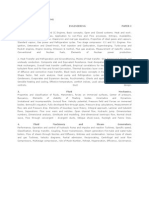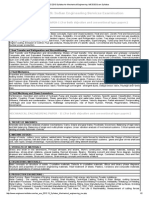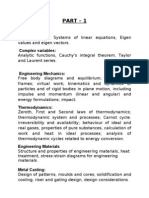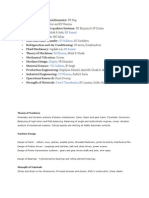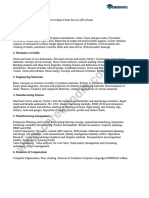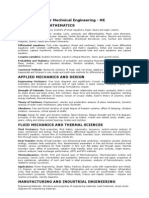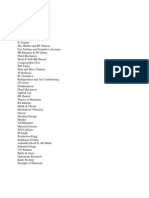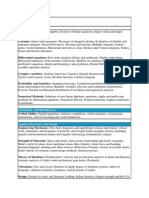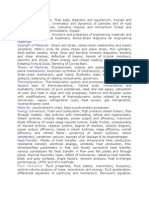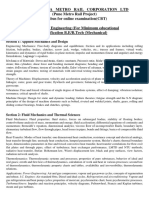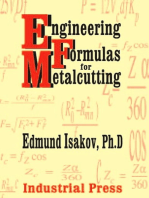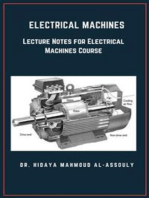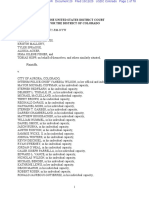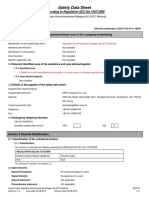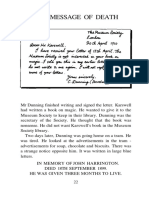Syllabus Ies
Syllabus Ies
Uploaded by
girish1609740013Copyright:
Available Formats
Syllabus Ies
Syllabus Ies
Uploaded by
girish1609740013Copyright
Available Formats
Share this document
Did you find this document useful?
Is this content inappropriate?
Copyright:
Available Formats
Syllabus Ies
Syllabus Ies
Uploaded by
girish1609740013Copyright:
Available Formats
SYLLABUS OF IES MECHANICAL ENGINEER MECHANICAL ENGINEERING (For both objective and conventional type papers) PAPER-I
1. Thermodynamics: Cycles and IC Engines, Basic concepts, open and closed systems, Heat and work, Zeroth, First and Second Law, Application to non-Flow and Flow processes. Entropy, Availability, Irreversibility and Tds relations. Claperyron and real gas equations, Properties of ideal gases and vapors. Standard vapour, Gas power and Refrigeration cycles. Two stage compressor. C-I and S.I. Engines. Pre-ignition, Detonation and Diesel-knock, Fuel injection and Carburation, Supercharging. Turbo-prop and Rocket engines, Engine Cooling, Emission & Control, Flue gas analysis, Measurement of Calorific values. Conventional and Nuclear fuels, Elements of Nuclear power production. 2. Heat Transfer and Refrigeration and Air-conditioning: Modes of heat transfer. One dimensional steady and unsteady conduction. Composite slab and Equivalent Resistance. Heat dissipation from extended surfaces, Heat exchangers, Overall heat transfer coefficient, Empirical correlations for heat transfer in laminar and turbulent flows and for free and forced Convection, Thermal boundary layer over a flat plate. Fundamentals of diffusive and connective mass transfer, Black body and basic concepts in Radiation, Enclosure theory, Shape factor, Net work analysis. Heat pump and Refrigeration cycles and systems, Refrigerants. Condensers, Evaporates and Expansion devices, Psychrometry, Charts and application to air conditioning, Sensible heating and cooling, Effective temperature, comfort indices, Load calculations, Solar refrigeration, ontrols, Duct design. 3. Fluid Mechanics: Properties and classification of fluids, Manometry, forces on immersed surfaces, Center of pressure, Buoyancy, Elements of stability of floating bodies. Kinematics and Dynamics. Irrotational and incompressible. Inviscid flow. Velocity potential, Pressure field and Forces on immersed bodies. Bernoulli's equation, Fully developed flow through pipes, Pressure drop calculations, Measurement of flow rate and Pressure drop. Elements of boundary layer theory, Integral approach, Laminar and tubulent flows, Separations. Flow over weirs and notches. Open channel flow, Hydraulic jump. Dimensionless numbers, Dimensional analysis, Similitude and modelling. One-dimensional isentropic flow, Normal shock wave, Flow through convergent - divergent ducts, Oblique shock-wave, Rayleigh and Fanno lines. 4. Fluid Machinery and Steam Generators: Performance, Operation and control of hydraulic Pump and impulse and reaction Turbines, Specific speed, Classification. Energy transfer, Coupling, Power transmission, Steam generators Fire-tube and water-tube boilers. Flow of steam through Nozzles and Diffusers, Wetness and condensation. Various types of steam and gas Turbines, Velocity diagrams. Partial admission. Reciprocating, Centrifugal and axial flow Compressors, Multistage compression, role of Mach Number, Reheat, Regeneration, Efficiency, Governance.
PAPER II
5. THEORY OF MACHINES: Kinematic and dynamic analysis of planer mechanisms. Cams. Gears and gear trains. Flywheels. Governors. Balancing of rigid rotors and field balancing. Balancing of single and multicylinder engines, Linear vibration analysis of mechanical systems. Critical speeds and whirling of shafts Automatic controls. 6. MACHINE DESIGN : Design of Joints : cotters, keys, splines, welded joints, threaded fasteners, joints formed by interference fits. Design of friction drives : couplings and clutches, belt and chain drives, power screws. Design of Power transmission systems: gears and gear drives shaft and axle, wire ropes. Design of bearings: hydrodynamics bearings and rolling element bearings. 7. STRENGTH OF MATERIALS: Stress and strain in two dimensions, Principal stresses and strains, Mohr's construction, linear elastic materials, isotropy and anisotropy, stress-strain relations, uniaxial loading, thermal stresses. Beams: Bending moment and shear force diagram, bending stresses and deflection of beams. Shear stress distribution. Torsion of shafts, helical springs. Combined stresses, thick-and thin-walled pressure vessels. Struts and columns. train energy concepts and theories of failure. 8. ENGINEERING MATERIALS: Basic concepts on structure of solids. Crystalline maferials. Detects in crystalline materials. Alloys and binary phase diagrams. Structure and properties of common engineering materials. Heat treatment of steels. Plastics, Ceramics and composite materials. Common applications of various materials. 9. PRODUCTION ENGINEERING : Metal Forming : Basic Principles of forging, drawing and extrusion; High energy rate forming; Powder metallurgy. Metal Casting : Die casting, investment casting, Shall Moulding, Centrifugal Casting, Gating & Riser design; melting furnaces. Fabrication Processes : Principles of Gas, Arc, Shielded arc Welding; Advanced Welding Processes, Weldability: Metallurgy of Welding. Metal Cutting : Turning, Methods of Screw Production, Drilling, Boring, Milling, Gear Manufacturing, Production of flat surfaces, Grinding & Finishing Processes. Computer Controlled Manufacturing Systems-CNC, DNC, FMS, Automation and Robotics. Cutting Tools Materials, Tool Geometry, Mechanism of Tool Wear, Tool Life & Machinability; Measurement of cutting forces. Economics of Machining. Unconventional Machining Processes. Jigs and Fixtures. Fits and tolerances, Measurement of surface texture, Comparators Alignment tests and reconditioning of Machine Tools. 10. INDUSTRIAL ENGINEERING: Production Planning and Control : Forecasting - Moving average, exponential smoothing, Operations, scheduling; assembly line balancing, Product development, Break-even analysis, Capacity planning, PERT and CPM. Control Operations : Inventory control ABC analysis, EOQ model, Materials requirement planning. Job design, Job standards, Work measurement, Quality Management - Quality analysis and control. Operations Research : Linear Programming - Graphical and Simplex methods, Transportation and assignment models. Single server ueueing model. Value Engineering : Value analysis for cost/value. 11. ELEMENTS OF COMPUTATION: Computer Organisation, Flow charting, Features of Common computer Languages FORTRAN, d Base III, Lotus 1-2-3, C and elementary Programming.
You might also like
- Machine Design Elements and AssembliesFrom EverandMachine Design Elements and AssembliesRating: 3.5 out of 5 stars3.5/5 (2)
- The Essentials of Material Science and Technology for EngineersFrom EverandThe Essentials of Material Science and Technology for EngineersRating: 5 out of 5 stars5/5 (1)
- Calibration Laboratory Depth Micro Meter: Revision Record SheetDocument8 pagesCalibration Laboratory Depth Micro Meter: Revision Record SheetManivasagan VasuNo ratings yet
- Mechanical Engineering Paper-I: (For Both Objective and Conventional Type PapersDocument5 pagesMechanical Engineering Paper-I: (For Both Objective and Conventional Type PapersSachin KalsiNo ratings yet
- Syllabus IesDocument3 pagesSyllabus IesAbhinav BansalNo ratings yet
- C) - Mechanical Engineering Syllabus of Ies 2014: Paper I 1. ThermodynamicsDocument3 pagesC) - Mechanical Engineering Syllabus of Ies 2014: Paper I 1. ThermodynamicsPalat L SutngaNo ratings yet
- Mechanical Engineering Paper: 1. ThermodynamicsDocument3 pagesMechanical Engineering Paper: 1. Thermodynamicsjithinaravind007No ratings yet
- Mechanical Engineering PaperDocument3 pagesMechanical Engineering PaperAkshay JoshiNo ratings yet
- Fluid MechanicsDocument1 pageFluid MechanicssharathbabuvNo ratings yet
- Syllabus For IES: Indian Engineering Services ExaminationDocument2 pagesSyllabus For IES: Indian Engineering Services Examinationadityanarang147No ratings yet
- Heat Transfer and Refrigeration and Airconditioning - ÊÊDocument3 pagesHeat Transfer and Refrigeration and Airconditioning - ÊÊVaibhava SrivastavaNo ratings yet
- IES 2013 Syllabus For Mechanical Engineering - ME ESE Exam SyllabusDocument3 pagesIES 2013 Syllabus For Mechanical Engineering - ME ESE Exam Syllabusjaved alamNo ratings yet
- Syllabus:: Indian Engineering Services ExaminationDocument5 pagesSyllabus:: Indian Engineering Services ExaminationsameerkiitNo ratings yet
- Rajiv Gandhi Proudyogiki Vishwavidyalaya, Bhopal (M.P.)Document3 pagesRajiv Gandhi Proudyogiki Vishwavidyalaya, Bhopal (M.P.)FlyNarutoFly27No ratings yet
- Indicative Syllabus of Mechanical EngineeringDocument4 pagesIndicative Syllabus of Mechanical EngineeringSuryesh PathakNo ratings yet
- Syllabus of Exam: General Ability TestDocument4 pagesSyllabus of Exam: General Ability TestManvendra SinghNo ratings yet
- Aee Mech SyllabusDocument1 pageAee Mech SyllabusNikhil GaripelliNo ratings yet
- Psu Syllabus MechanicalDocument2 pagesPsu Syllabus Mechanicalammu0312No ratings yet
- Ies My SyllabusDocument6 pagesIes My Syllabusamrish6393No ratings yet
- Indicative Syllabus of Mechanical EngineeringDocument4 pagesIndicative Syllabus of Mechanical EngineeringManinder Singh SainiNo ratings yet
- Thermodynamics.: Target-GateDocument5 pagesThermodynamics.: Target-GateKrishna Murari MauryaNo ratings yet
- Part - 1: ThermodynamicsDocument8 pagesPart - 1: ThermodynamicsparveenmeNo ratings yet
- Mechanical Engineering Subject Duration - Maximum Marks Section I-Objective PapersDocument4 pagesMechanical Engineering Subject Duration - Maximum Marks Section I-Objective Paperssudheer92No ratings yet
- MPSC Mechanical Engineering Main SyllabusDocument6 pagesMPSC Mechanical Engineering Main SyllabusD JNo ratings yet
- IES Mech Engg Syllabus 2017Document2 pagesIES Mech Engg Syllabus 2017AbhishekVermaNo ratings yet
- Uppsc Ae SyllabusDocument2 pagesUppsc Ae Syllabussujeet singhNo ratings yet
- RK Bansal JP Hollman RK Bansal RS Khurmi Shigley WD Callister O P Khanna Gere TimoshenkoDocument4 pagesRK Bansal JP Hollman RK Bansal RS Khurmi Shigley WD Callister O P Khanna Gere Timoshenkopatrik710No ratings yet
- Mechanical EngineeringDocument2 pagesMechanical EngineeringMECHANICAL DESIGN ZONENo ratings yet
- IES Mechanical SyllabusDocument4 pagesIES Mechanical SyllabusShyam MajhiNo ratings yet
- Fluid Mechanics: Mechanical EngineeringDocument5 pagesFluid Mechanics: Mechanical EngineeringErin BarryNo ratings yet
- Syllabus M. TECH. ENTRANCE TEST-2018-19 Mechanical Engineering Department Jamia Milla Islamia, New DelhiDocument2 pagesSyllabus M. TECH. ENTRANCE TEST-2018-19 Mechanical Engineering Department Jamia Milla Islamia, New DelhiAbid YusufNo ratings yet
- Gate+ Ese Combined Syllabus: Section 2: Applied Mechanics and DesignDocument4 pagesGate+ Ese Combined Syllabus: Section 2: Applied Mechanics and Designgopal dasNo ratings yet
- Mechanical Engineering SyllabusDocument3 pagesMechanical Engineering SyllabustarunNo ratings yet
- Ets Me MtechDocument3 pagesEts Me Mtechlee03002523604No ratings yet
- Drdo Syllabus MechanicalDocument2 pagesDrdo Syllabus MechanicalArvind SinghNo ratings yet
- Gate Me Syllabus 2014Document4 pagesGate Me Syllabus 2014Hittendra SinghNo ratings yet
- Paper I Syllabus: 1. Thermodynamics, Cycles and IC EnginesDocument3 pagesPaper I Syllabus: 1. Thermodynamics, Cycles and IC EnginesAvinash KumarNo ratings yet
- Mech Gate SyllabusDocument2 pagesMech Gate SyllabuscpprodNo ratings yet
- Syllabus Inspector Factories Boilers (Factories & Boilers Deptt)Document2 pagesSyllabus Inspector Factories Boilers (Factories & Boilers Deptt)mittalnipun2009No ratings yet
- Ias Mechanical EnggDocument2 pagesIas Mechanical EnggkawalhayerNo ratings yet
- GATE Syllabus For Mechnical Engineering - ME Engineering MathematicsDocument2 pagesGATE Syllabus For Mechnical Engineering - ME Engineering MathematicsHusain K.N.No ratings yet
- Gate Engineering SyllabusDocument2 pagesGate Engineering SyllabusKarthick VenkateshNo ratings yet
- Mechanical Gate SyllabusDocument2 pagesMechanical Gate SyllabusmicmechNo ratings yet
- Subject AuthorDocument9 pagesSubject AuthorvupputuriNo ratings yet
- Syllabus: Syllabus For Electrical Branch Section-A (80marks) : 1.electrical Circuits and NetworksDocument9 pagesSyllabus: Syllabus For Electrical Branch Section-A (80marks) : 1.electrical Circuits and NetworksGopiNo ratings yet
- GATE Mechanical EngineeringDocument3 pagesGATE Mechanical EngineeringShiron K JohnsonNo ratings yet
- Discipline: Mechanical EngineeringDocument3 pagesDiscipline: Mechanical EngineeringAshish TanwarNo ratings yet
- HPSC Me SyllabusDocument1 pageHPSC Me SyllabusSatish KumarNo ratings yet
- Gate 2012 Me SyllabusDocument2 pagesGate 2012 Me SyllabusDeepak KushwahaNo ratings yet
- Gate SyllDocument3 pagesGate Syllalways23100% (2)
- General Aptitude (Ga) :: Engineering MathematicsDocument3 pagesGeneral Aptitude (Ga) :: Engineering MathematicsreddygjNo ratings yet
- NTPC SyllabusDocument3 pagesNTPC SyllabusVimleshKumarSharma100% (1)
- Syllabus For Mechanical Engineering (Me) : Linear AlgebraDocument4 pagesSyllabus For Mechanical Engineering (Me) : Linear Algebrachauhan.nutanNo ratings yet
- Mechanical Engineering - (HARIKRISHNAN.V.) Paper - I 1. Fluid MechanicsDocument3 pagesMechanical Engineering - (HARIKRISHNAN.V.) Paper - I 1. Fluid MechanicsHari650No ratings yet
- Gate Syllbus MeDocument3 pagesGate Syllbus Mesameersaurabh5No ratings yet
- MMRCDocument2 pagesMMRCLaxman KadamNo ratings yet
- IES Syllabus MechanicalDocument3 pagesIES Syllabus MechanicalAbhishek HiremathNo ratings yet
- IES Syllabus For Mechanical Engineering IES 2015 Syllabus MEDocument5 pagesIES Syllabus For Mechanical Engineering IES 2015 Syllabus MERohitMishraNo ratings yet
- Electrical Machines: Lecture Notes for Electrical Machines CourseFrom EverandElectrical Machines: Lecture Notes for Electrical Machines CourseNo ratings yet
- Nuclear Reactor Thermal-Hydraulics: Past, Present and Future: Enter asset subtitleFrom EverandNuclear Reactor Thermal-Hydraulics: Past, Present and Future: Enter asset subtitleNo ratings yet
- Rip Van WinkleDocument42 pagesRip Van Winkleshh shhNo ratings yet
- Vertical Stress in The GroundDocument12 pagesVertical Stress in The GroundRabindraSubediNo ratings yet
- Nature Versus Machine 2022Document10 pagesNature Versus Machine 2022Derfel CardanNo ratings yet
- Install & Configure Squid in Ubuntu - Linux Fundamentals PDFDocument5 pagesInstall & Configure Squid in Ubuntu - Linux Fundamentals PDFArdan ArasNo ratings yet
- Product Bulletin Fisher 2625 2625sst 2625ns Volume Boosters en 123054Document8 pagesProduct Bulletin Fisher 2625 2625sst 2625ns Volume Boosters en 123054gmurali2kNo ratings yet
- WifiDocument133 pagesWifiyadi1982No ratings yet
- Lindsay Minter, Et Al., v. City of Aurora, Et Al.: Amended ComplaintDocument78 pagesLindsay Minter, Et Al., v. City of Aurora, Et Al.: Amended ComplaintMichael_Roberts2019No ratings yet
- The Triple Bottom LineDocument2 pagesThe Triple Bottom LineHương GiangNo ratings yet
- Looking Beyond The Horizon - The Physics of Anatomy and Function - Gracovetsky - Aug 2014Document9 pagesLooking Beyond The Horizon - The Physics of Anatomy and Function - Gracovetsky - Aug 2014차민기No ratings yet
- Analog and Digital SignalsDocument2 pagesAnalog and Digital SignalsMark ReyesNo ratings yet
- Y710Document2 pagesY710RimNo ratings yet
- Basic Contractor Safety PlanDocument23 pagesBasic Contractor Safety Plankawawa.narestrictNo ratings yet
- MSDS AstDocument6 pagesMSDS AstKRRNo ratings yet
- 2018 Projects Compendia IeN WiAmc7SDocument149 pages2018 Projects Compendia IeN WiAmc7Sucbscholarship officeNo ratings yet
- Tic MachineDocument33 pagesTic MachineDaniel AlmendarezNo ratings yet
- G190ean01 0Document28 pagesG190ean01 0kalanghoNo ratings yet
- Automatic Enrolment Online Registration ChecklistDocument2 pagesAutomatic Enrolment Online Registration ChecklistzoyaNo ratings yet
- Rohtas DistrictDocument107 pagesRohtas DistrictUmesh MishraNo ratings yet
- DH 1123Document14 pagesDH 1123The Delphos HeraldNo ratings yet
- Bosque 0304-8799: Issn: Revistabosque@uach - CLDocument9 pagesBosque 0304-8799: Issn: Revistabosque@uach - CLFrancisco MartínezNo ratings yet
- AUTEC REMOTE CONTROL - LIUACFHJ0 - Eng-00Document16 pagesAUTEC REMOTE CONTROL - LIUACFHJ0 - Eng-00Technical TerraEcoBuildNo ratings yet
- The Message of The DeathDocument13 pagesThe Message of The DeathLesly Jaliri HuallpaNo ratings yet
- En (1323)Document1 pageEn (1323)reacharunkNo ratings yet
- Professional Disc Recorder PDW-HD1200Document178 pagesProfessional Disc Recorder PDW-HD1200Alfonso CalderonNo ratings yet
- Material All 2Document5 pagesMaterial All 2Albino RibSarNo ratings yet
- Workshop 2 - Annex B - E - Site - Eval - RankingDocument11 pagesWorkshop 2 - Annex B - E - Site - Eval - RankingCharonel GalendezNo ratings yet
- Libro de Inglés PreescolarDocument10 pagesLibro de Inglés Preescolarvanesaarellano95No ratings yet
- Endodontic RetreatmentDocument59 pagesEndodontic RetreatmentOmar MustafaNo ratings yet
- Design Principles: 1. Principle of Least PrivilegeDocument3 pagesDesign Principles: 1. Principle of Least PrivilegeASHUTOSH SONINo ratings yet




